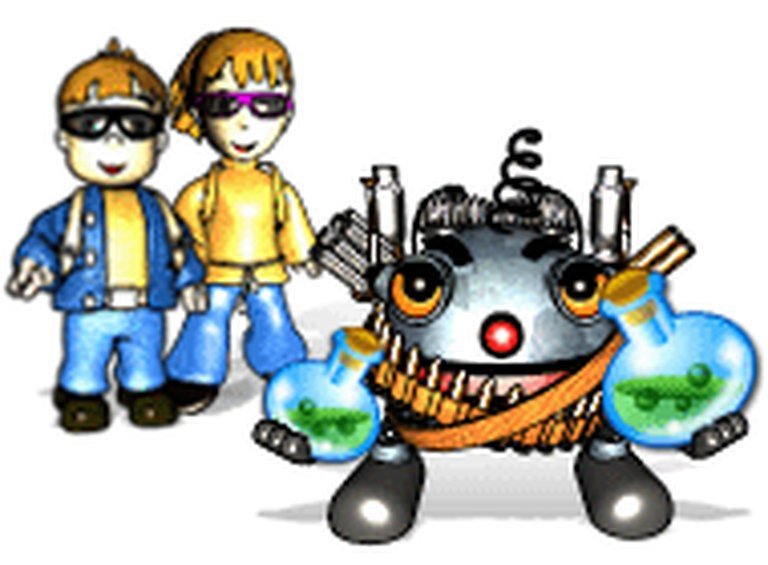- Release Year: 2006
- Platforms: Windows
- Publisher: Alawar Entertainment, Inc.
- Developer: Miga Studio
- Genre: Action
- Perspective: Top-down
- Game Mode: Single-player
- Gameplay: Arcade, Bomb placement, Puzzle elements
- Setting: The Lost Temple, The Northern Way, The Secret Garden
- Average Score: 61/100

Description
In Rikki and Mikki to the Rescue! the two siblings set out to save their kidnapped grandfather, traveling through three themed worlds—The Secret Garden, The Lost Temple, and the Northern Way—using Bomberman‑style bombs to defeat mummies, ghosts, robots and other foes, collect jewels and coins, and battle bosses amid shifting maps and power‑up surprises.
Rikki and Mikki to the Rescue!: A Bomberman Clone’s Quest for Casual Greatness
Introduction
In the mid-2000s casual gaming boom, Rikki and Mikki to the Rescue! emerged as a charming yet derivative entry in the top-down arcade-puzzle genre. Developed by Miga Studio and published by Alawar Entertainment in 2006, the game wears its Bomberman influences boldly, inviting comparisons while carving a niche with family-friendly aesthetics and inventive level gimmicks. This review explores whether its 60 levels of bomb-detonating chaos transcend its imitative roots to earn a place in gaming history—or if it remains a footnote in Alawar’s catalog of casual hits.
Development History & Context
Studio Vision & Era Constraints
Miga Studio, a Ukrainian developer, aimed to capitalize on the rising demand for accessible, pick-up-and-play titles during the shareware era. With limited resources, the team—led by programmer Ivan Matseiko and artist Aleksandr Gimik—leveraged the Bomberman formula to create a game that could run on low-spec PCs (minimum: Pentium III, 128MB RAM, Windows 98). Alawar Entertainment, known for distributing casual games like Farm Frenzy, positioned Rikki and Mikki as a budget-friendly title, sold via digital download.
The 2000s saw a surge in Bomberman clones, but few targeted casual audiences. Miga’s decision to streamline mechanics (no multiplayer, simplified controls) reflected an understanding of the market: players wanted quick sessions with minimal learning curves. Yet, the lack of online leaderboards or competitive modes limited its longevity.
Narrative & Thematic Deep Dive
A Lightweight Adventure
The plot is straightforward: siblings Rikki and Mikki rescue their scientist grandfather, kidnapped by “forces from beyond.” The journey spans three realms—The Secret Garden, The Lost Temple, and The Northern Way—each with 20 levels. Dialogue is minimal, and character development nonexistent, but the premise serves its purpose: a whimsical excuse to bomb mummies, robots, and ghosts.
Themes of familial loyalty and perseverance are surface-level, but the game’s tone—bright, cartoonish, and devoid of tension—aligns with its casual audience. Unlike Bomberman’s abstract arenas, Rikki and Mikki injects light storytelling to contextualize its worlds, such as ancient temples and frosty pathways. It’s a narrative veneer, but one that adds cohesion to the level design.
Gameplay Mechanics & Systems
Bombs, Jewels, and Repetition
The core loop echoes Bomberman: navigate grid-based levels, place bombs to destroy obstacles, collect jewels to unlock exits, and avoid enemies. However, Miga introduced twists:
– Dynamic Level Mechanics: Some stages darken except for explosion-lit areas; others shift terrain with each detonation.
– Power-Ups: Temporary speed boosts, invincibility, and chain-reaction dynamite stacks add strategy.
– Boss Battles: Each world concludes with a boss requiring players to dodge explosives while gathering keys.
While polished, the 60-level structure grows repetitive. Objectives rarely evolve beyond “collect all jewels,” and enemy AI is simplistic. The absence of multiplayer—a hallmark of Bomberman—hurts its replayability, though the focus on solo play suited its casual audience.
UI & Controls
Keyboard and mouse controls are responsive but barebones. The interface is minimalist, prioritizing clarity over flair—a pragmatic choice for low-resolution monitors.
World-Building, Art & Sound
Aesthetic Charm
Aleksandr Gimik’s art direction shines with vibrant, cartoonish visuals. Each world has distinct motifs: The Secret Garden bursts with greenery, The Lost Temple leans on Aztec-inspired ruins, and The Northern Way features icy, crystalline backdrops. Characters and enemies are stylized, with playful animations (e.g., ghosts comically recoiling from explosions).
The soundtrack by The Sands complements the upbeat tone, though tracks are forgettable. Sound effects—crisp explosions, jingles for collectibles—enhance feedback without overwhelming. The game’s simplicity is its strength: it runs smoothly even on dated hardware, ensuring accessibility.
Reception & Legacy
Mixed Impact
Critics praised its casual appeal. GameXtazy’s 80% review called it a “near-perfect example of the casual genre,” though noting repetitiveness. Player reviews averaged 3.7/5, reflecting appreciation for its polish but frustration at its lack of depth.
Its legacy is muted. While Alawar continued to dominate casual markets with titles like Plantopia, Rikki and Mikki faded into obscurity, overshadowed by indie darlings (Geometry Wars) and Bomberman’s enduring popularity. However, its experimentation with light/dark mechanics and terrain-shifting levels influenced later puzzle games like Bomb Chicken.
Conclusion
Rikki and Mikki to the Rescue! is a competent clone that understands its audience. Its vibrant art, inventive level designs, and accessibility make it a worthwhile time capsule of mid-2000s casual gaming. Yet, its lack of innovation and repetitive structure relegate it to a historical curiosity rather than a genre-defining titan. For retro enthusiasts or Bomberman fans seeking a family-friendly spin, it’s a charming diversion—but one that never fully escapes the shadow of its inspiration.
Final Verdict: A solid, if unremarkable, entry in the arcade-puzzle canon—proof that even derivatives can spark joy when crafted with care.